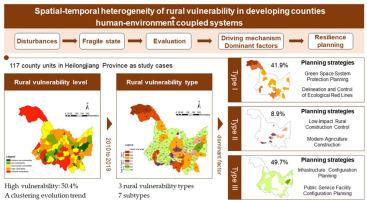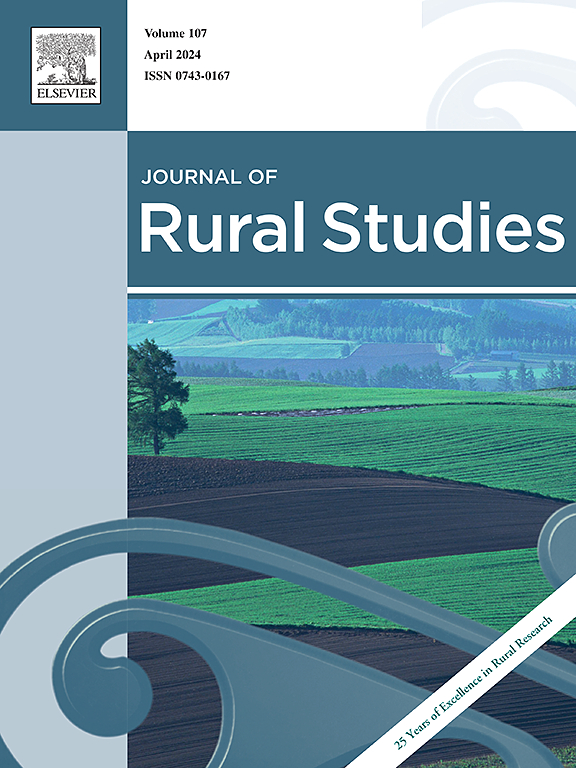Spatial-temporal patterns and driving mechanism of rural vulneraiblity at county level:A case study of 117 counties in Heilongjiang Province, China
IF 5.7
1区 社会学
Q1 GEOGRAPHY
引用次数: 0
Abstract
Rural vulnerability is used to understand the potential multi-hazard threats and describe the fragile state of rural areas, which engage decision-makers in developing policies and strategies to reduce vulnerability. Existing studies about rural vulnerability focused on the single exogenous disturbance but paid inadequate attention to the multi-disturbances of rural coupled human-environment system. In addition, current studies mainly analyzed the spatial differentiation of vulnerability degree, ignoring the temporal evolution and the internal elements’ relationships of rural systems. In this study, we structured the cognition of rural vulnerability with a framework for understanding coupled human-environment system, evaluated rural vulnerability with the dimensions of exposure, sensitivity and adaptability, and analyzed the driving mechanism based on spatial-temporal heterogeneity. Taking 117 county units in Heilongjiang Province as study cases, we found that (1) rural vulnerability was indeed significant, as the area of county units with extreme or high vulnerability levels accounts for 50.4% of the total area, indicating a trend of high vulnerability in the counties on the north and south sides and low vulnerability in the center. (2) The spatial-temporal heterogeneity of rural vulnerability presented a clustering trend, shifting from a relatively balanced spatial distribution from 2010 to 2013 to a state of vulnerability aggregation at all levels from 2016 to 2019. (3) Rural vulnerability was mainly affected by changes in the principal factors of sensitivity and adaptability, and driving sources mainly generated by human activities, which was largely derived from rural construction activities and government policy guidance on rural regulation. Based on the results, we classified county units into different rural vulnerability types, put forward a rural resilience planning mode of “General + Special” with planning strategies for each type, which can be used as a reference for rural planning positioning of county and township level land spatial planning in the national territory spatial planning.

县域农村脆弱性的时空格局与驱动机制:黑龙江省 117 个县的案例研究
农村脆弱性被用来了解潜在的多种灾害威胁,描述农村地区的脆弱状态,使决策者参与制定降低脆弱性的政策和战略。现有的农村脆弱性研究主要关注单一的外源干扰,而对农村人-环境耦合系统的多重干扰关注不够。此外,现有研究主要分析了脆弱性程度的空间分异,忽视了农村系统的时间演变和内部要素关系。本研究以人类-环境耦合系统认识框架构建农村脆弱性认知,从暴露度、敏感性和适应性维度评价农村脆弱性,并基于时空异质性分析其驱动机制。以黑龙江省 117 个县域单元为研究案例,我们发现:(1)农村脆弱性确实显著,极度或高度脆弱性的县域单元面积占总面积的 50.4%,显示出南北两侧县域高脆弱性和中部低脆弱性的趋势。(2)农村脆弱性的时空异质性呈现集聚趋势,由2010-2013年的空间分布相对均衡转变为2016-2019年的各级脆弱性集聚状态。(3)农村脆弱性主要受敏感性和适应性主因子变化的影响,驱动源主要由人类活动产生,主要来源于农村建设活动和政府对农村调控的政策引导。根据研究结果,我们将县域单元划分为不同的农村脆弱性类型,提出了 "一般+特殊 "的农村韧性规划模式,并针对每种类型提出了规划策略,可作为国土空间规划中县乡两级国土空间规划对农村规划定位的参考。
本文章由计算机程序翻译,如有差异,请以英文原文为准。
求助全文
约1分钟内获得全文
求助全文
来源期刊

Journal of Rural Studies
Multiple-
CiteScore
9.80
自引率
9.80%
发文量
286
期刊介绍:
The Journal of Rural Studies publishes research articles relating to such rural issues as society, demography, housing, employment, transport, services, land-use, recreation, agriculture and conservation. The focus is on those areas encompassing extensive land-use, with small-scale and diffuse settlement patterns and communities linked into the surrounding landscape and milieux. Particular emphasis will be given to aspects of planning policy and management. The journal is international and interdisciplinary in scope and content.
 求助内容:
求助内容: 应助结果提醒方式:
应助结果提醒方式:


